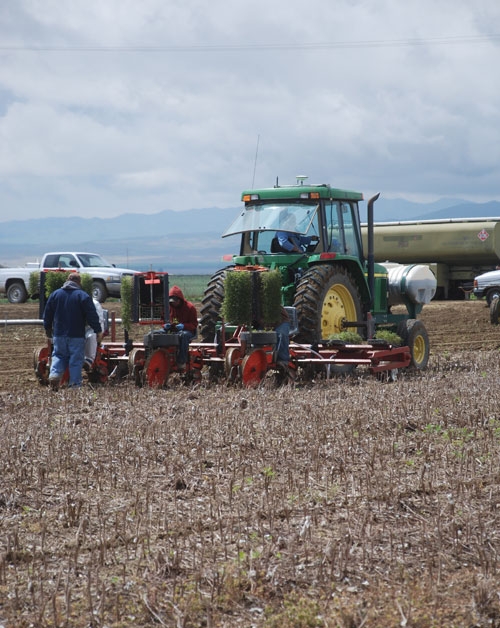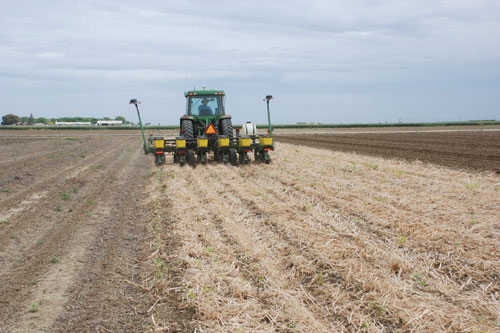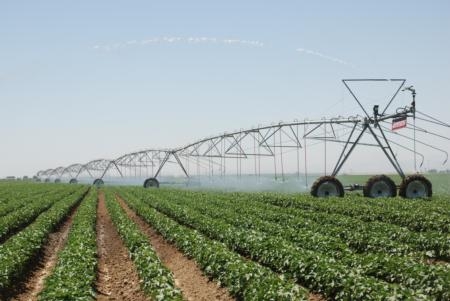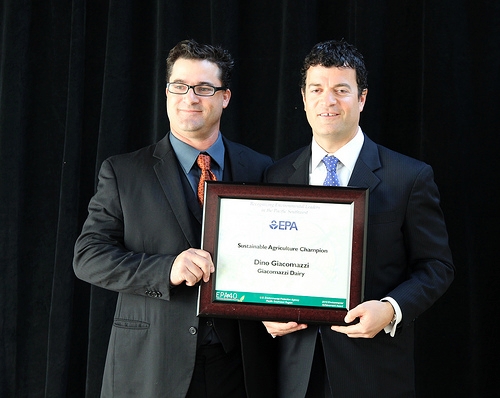
Posts Tagged: conservation tillage
Weed control strategies and yield response in a pepper crop (Capsicum annuum L.) mulched with hairy vetch (Vicia villosa Roth.) and oat (Avena sativa L.) residues
Abstract: Organic mulches could be a part of a wide strategy of integrated weed management in...
Record no-till yields achieved in 2011

“The bar has been set,” said UC Cooperative Extension vegetable crops specialist Jeff Mitchell. “After toiling for more than a decade, we’ve finally succeeded in putting the pieces together this past season.”
Researchers harvested 3.4 bales per acre of cotton and 53 tons per acre of processing tomatoes using no-till techniques. Plots managed with conventional tillage practices averaged about 3.4 bales per acre for cotton and 49 tons per acre for tomatoes.
The research was conducted at the UC West Side Research and Extension Center near Five Points, Calif. Scientists established the cotton crop by direct seeding into beds that had not been touched since the preceding tomato crop, except by two herbicide sprays. The 2011 tomato crop was established with a no-till transplanter following the 2010 cotton crop, which had only been shredded and root-pulled under a waiver granted by CDFA’s Pink Bollworm Eradication Program.
The 2011 regime represented the first time since the start of the study in 1999 that the Five Points research team strictly followed no-tillage techniques for both crops. In past years, in which tomato yields reached the mid-60 tons per acre, in-season cultivation for weed control was used. In 2011, however, the goal of going completely no-till was realized in preparation for 2012, when the field will be converted to subsurface drip irrigation for all subsequent no-till plantings. Scientists believe the 2011 tomato harvest for both conventional and no-till plots was lower than in previous years because planting took place April 7 due to weather and scheduling delays.
UC Cooperative Extension agricultural economist Karen Klonsky estimates that switching to no-till production reduced expenditures by about $135 per acre for the tomato crop and about $40 per acre for cotton.

Future goals for conservation tillage production systems include profitability, resource quality, conservation, as well as broader ecosystem services.
“No-till makes sense as a means for lowering production costs and cutting dust and greenhouse gas emissions,” Mitchell said. “No-till also improves soil functions, such as increased carbon storage, greater stability of soil aggregates, increased porosity and water infiltration, and a larger population of earthworms.”
The benefits of no-till farming have been recognized by researchers and farmers in other regions, such as the Great Plains and the Pacific Northwest regions of the U.S., across much of Canada, and also throughout large areas of South America.
“These benefits start to pile up pretty fast once longer-term and broader sustainability goals are factored in,” Mitchell said.
Mitchell and his Five Points team are part of California’s Conservation Agriculture Systems Institute (CASI), a diverse group of more than 1,500 farmers, industry representatives, university, Natural Resource Conservation Service and other public agency members. Over the past 10 years, the team has come together to develop information on the true costs and benefits of the production system and irrigation management alternatives and to help develop appropriate sustainability goals for the long haul. For more information on the body of CT research, see the UC Conservation Tillage website.
“One of the things that CASI does is track changes in tillage management practices that are used throughout the San Joaquin Valley,” said long-time member and former air quality coordinator for the California Association of Resource Conservation Districts Ron Harben. “Our most recent survey for 2010 showed an increase of about 5 percent in no-till and strip-till acreage over previous years. As of 2010, over 47 percent of the cropland in the San Joaquin Valley is using some form of conservation tillage.”
Congressman praises UC research and extension
United States Congressman Jim Costa visited the UC West Side Research and Extension Center in Five Points last week to introduce his new legislative director, Nick Choate, to west side farming practices. A focus of the visit was conservation tillage, a farming system in which growers minimize tractor work and plant crops in the residue of a previous crop.
UC research has shown that CT practices have numerous benefits, including water conservation, dust suppression, reduced runoff, lower labor needs and costs, fuel savings and carbon sequestration. Members of the Conservation Tillage and Cropping Systems workgroup asked Costa for federal funding to study the adoption process and fund CT extension activities.
Costa is a member of the House Committee on Agriculture, which is laying the groundwork for the reauthorization of the Farm Bill in 2012.
He shared the following comments about the value of UC Agriculture and Natural Resources programs:
Conservation tillage hits the airwaves
A series of conservation tillage workshops last month and a follow-up news release by UC Davis cropping systems specialist Jeff Mitchell resulted in a story about the event on a Fresno morning ag show on KMJ 580 am radio. The radio story is archived online, about midway through the hour-long broadcast.
Mitchell conducted a phone interview with host Sean Michael Lisle in which he
said national experts on no-till and strip-till came to California to encourage the state's farmers to try conservation tillage, which can conserve water, suppress dust, reduce runoff, lower labor costs, save fuel and sequester carbon.
"There is a growing interest now in these kinds of systems that potentially can reduce production costs and can have a number of adjunct benefits associated with them, and that would be quite new for California," Mitchell said on the program. "Currently in California, very little of the annual crops, row crops, field crops are grown with these kinds of practices."
Mitchell said the dairy industry has been particularly receptive to the idea.
"Our workgroup has documented some rather significant changes in tillage practices in the last 6 years," Mitchell said. "The adoption of these kinds of practices has actually gone up to about 20 percent of the acreage from about 2 percent in that time period."
More information on conservation tillage is available on the workgroup's Conservation Tillage and Cropping Systems website.

More savings can be realized by combining overhead irrigation with conservation tillage.
UC collaborator named 'Sustainable Agriculture Champion' by EPA
Hanford dairy farmer Dino Giacomazzi was recognized for his innovations in conservation tillage yesterday at the U.S. Environmental Protection Agency’s 12th annual Environmental Awards Ceremony held in downtown Los Angeles, according to an EPA news release.
Giacomazzi was in good company. The 12 businesses and individuals honored included Governor Arnold Schwarzenegger, Fresno mayor Ashley Swearengin and a 14-year-old boy who recorded a song about global warming that reached children on five continents.
According to the release, Giacomazzi is the fourth generation to manage Giacomazzi Dairy, a family farm of 900 cows and 600 acres, which has operated at the same location in Hanford since 1893.
Giacomazzi approaches his farm as a holistic system, and is continually looking for cultural practices that are sustainable both environmentally and economically. Working with USDA-NRCS and the University of California, Giacomazzi initiated the first demonstration evaluation of a strip-tillage corn planting system in the Central San Joaquin Valley, and has been experimenting since with different implements, plant varieties and planting configurations to optimize that system.
Strip-tillage is a farming practice that involves tilling in narrow strips rather than disturbing soil in the entire field. This process reduces diesel, dust, and particulate emissions as well as fuel and labor costs. For his corn-wheat rotation, Giacomazzi has reduced the annual number of tillage passes for each of his fields from 14 to 2.
Giacomazzi received the Conservation Tillage Farmer Innovator Award for 2008 by the University of California and the U.S. Natural Resources Conservation Service Conservation Tillage Workgroup.
The EPA awards were presented on the agency’s 40th anniversary to help celebrate "40 Years of Environmentalism," the news release said.

Giacomazzi, right, receives EPA award from Jarod Blumenfeld, administrator of EPA Region 9.
